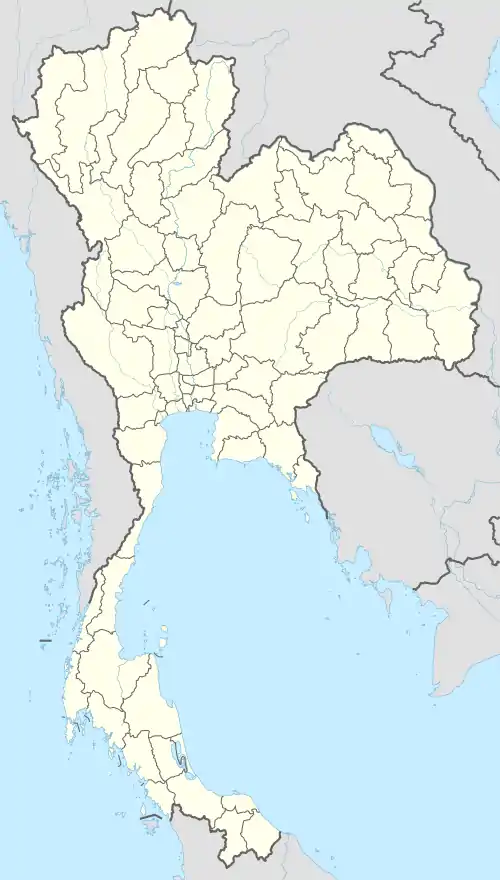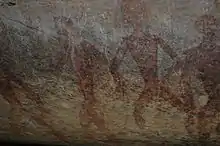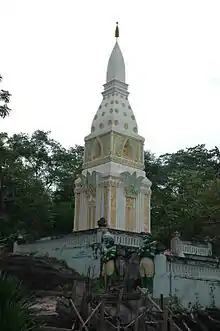Phu Phra Bat Historical Park
Phu Phra Bat (Thai: ภูพระบาท, pronounced [pʰūː pʰráʔ bàːt]) is a historical park in Ban Phue District, Udon Thani Province, Thailand. The park's distinguishing feature is its unusual rock formations around which religious shrines have been constructed. Some formations also feature prehistoric rock paintings.
| Phu Phra Bat historical park | |
|---|---|
Phu Phra Bat | |
 Hor Nang Usa | |
| Religion | |
| Affiliation | Hinduism |
| Province | Udon Thani |
| Deity | Buddha |
| Location | |
| Location | Ban Phue |
| Country | Thailand |
 Location in Thailand | |
| Geographic coordinates | 17°42′59″N 102°22′19″E |
| Architecture | |
| Type | Dvaravati, Lao |
The park was established by the Fine Arts Department of Thailand in 1991.[1]
Geography
Phu Phra Bat is located in the western zone of the Phu Phan Mountains between Udon Thani and Nong Khai, at a distance of about 65 kilometres (40 mi) from each city. The park's area is 1,200 acres (4.9 km2)[1] and is entirely within the Phu Phra Bat Buabok Forest Park.
Rock formations
The unusual rock formations in the park include spires, massive boulders and balanced rocks and form the backdrop for the prehistoric art and religious shrines created there.[2] The geological origins of these rocks are thought to be from under-sea erosion that occurred fifteen million years ago.[3]
Prehistoric art

Prehistoric art paintings on the rocks can best be seen where some rocks have formed a natural shelter. Others have faded considerably. The formations named Tham Wua and Tham Khon are particularly good examples; in the former oxen are depicted, the latter has human figures. The park's rock paintings are believed to date from 6,000 years ago.[3]
Mythology
Phu Phra Bat's rock formations are the setting for a local legend about a king, his daughter and her suitor. The park's most striking rock formation, Hor Nang Usa, is where the overprotective king forced his beautiful daughter to live. Despite her confinement, she was able to get a message out to her suitor prince and the two were married in defiance of her father.[3]
Religious shrines

Hor Nang Usa is one of a number of the rock formations where a shrine has been constructed. Early shrines date to the Dvaravati period in the seventh to tenth centuries. Shrines feature Hindu and Buddhist influences.
The park's most significant shrine is Wat Phra Putthabaht Bua Bok, where a Lao-style chedi covers a chamber housing a sandstone Buddha footprint. The shrine is a pilgrimage site with an annual festival held in March.[2][3]
References
- "Phu Phra Bat Historical Park". Tourism Authority of Thailand. Archived from the original on 16 April 2013. Retrieved 24 March 2013.
- Williams, China; Beales, Mark; Bewer, Tim (February 2012). Lonely Planet Thailand (14th ed.). Lonely Planet Publications. pp. 460. ISBN 978-1-74179-714-5.
- Gray, Paul; Ridout, Lucy (1995). Thailand - The Rough Guide (2nd ed.). Rough Guides Limited. p. 378. ISBN 1-85828-140-7.
| Wikimedia Commons has media related to Phu Phra Bat. |